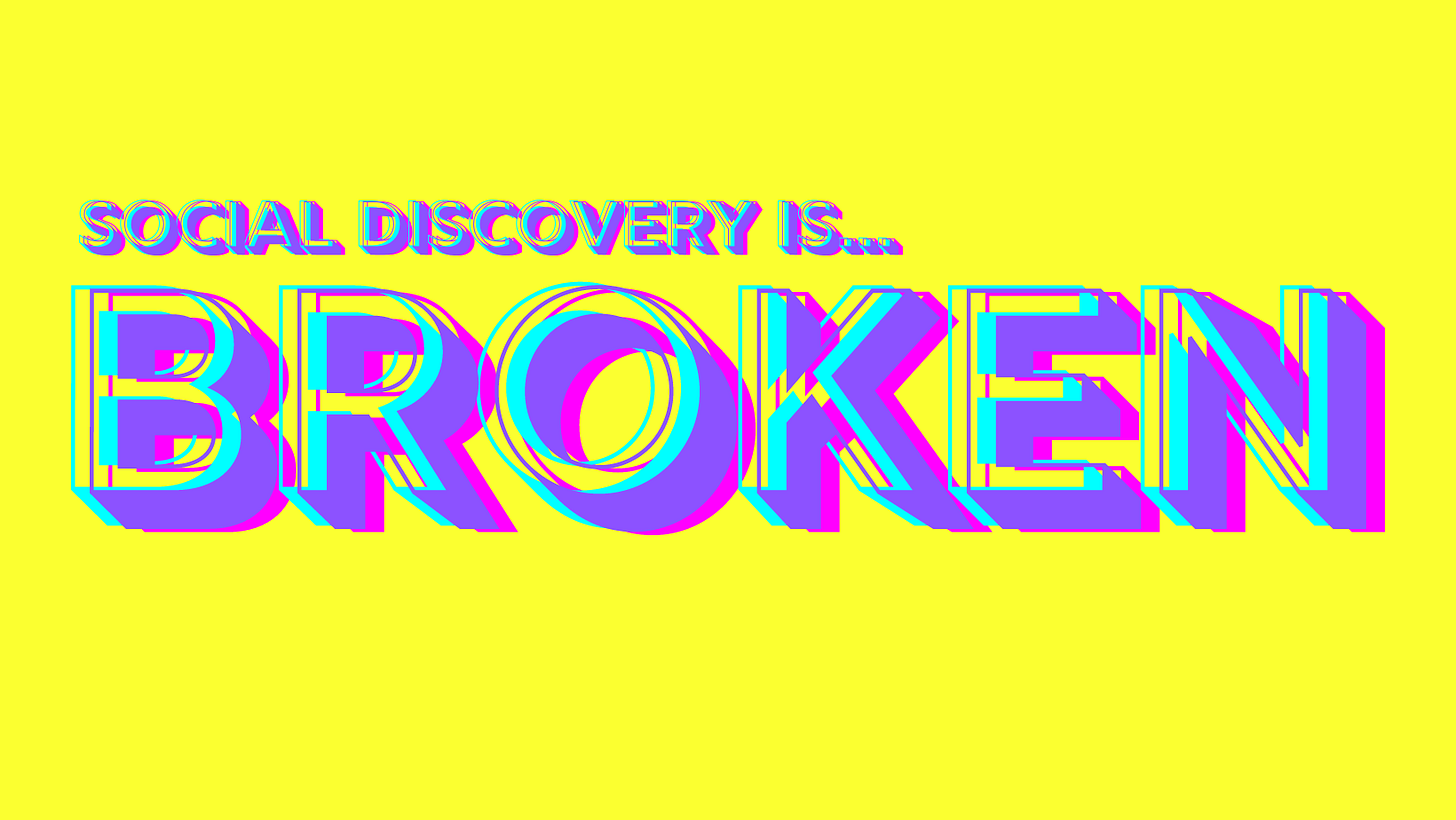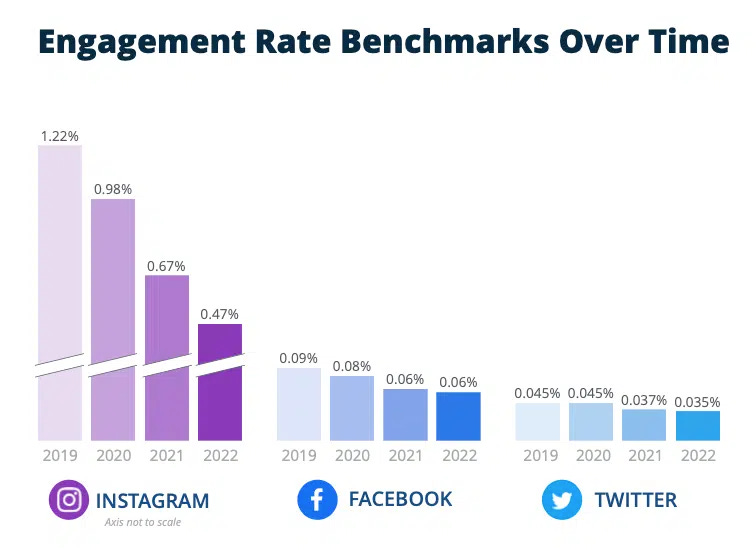First of all, thank you to everyone who voted or commented on our first post in this series. Overwhelmingly, 88% of people responding to the poll said that they thought content discovery through search and social was either not working, or they were seeing engagement dropping off. We also had a great comment from
, who has been working in the digital and non-profit space longer than pretty much anyone we know:“If things are bad for news websites now, you should take a look at how bad it has been (for a long time, actually) for small biz, non-profits and individual creators who used to be able to build an audience for their work and now can't. Traffic and engagement on Twitter cratered a while ago for Ada Lovelace Day and it's really hard to work out how to replace that.”
We work with a lot of non-profits and have definitely seen this over the last couple of years. It wasn’t only the digital news startups like Buzzfeed and Vice who based their audience development strategy on 3rd party platforms, but a lot of big charities and foundations as well. I was at the ComNet conference in Atlanta in September, the big annual event for comms teams in US non-profits. In the first keynote, Aimee Rinehart from AP gave this stark advice:
“Stop building somebody else’s app. Stop building out Twitter, stop building out Facebook, stop obeying whatever Google wants from you this month for SEO. Build. Your. Own. Audience.”
Amen to that. We’re going to suggest ways you can do that at the end of this series, but first, let’s take a closer look at how content discovery is broken on social.
What’s the insight?
I could link to dozens of articles we’ve been collecting at Storythings recently that are about the decline of engagement on social or variants of this article from Om Malik. They all say the same thing - the era of the social internet is over. But what do we mean by that? Even though I’m an aging Gen Xer who started socialising online with a cup modem and bulletin boards, I’m not going to make the nostalgia argument. Social Media didn’t ruin the internet - there were horrible people and communities right from the get-go - so I don’t want to make the argument that we need to return to an imaginary, ‘nicer’ version of the web that existed before the launch of the Facebook Platform in 2007.
Instead, I’ve been collecting stories about things like nappies (or diapers for our US readers). In an article this week for The Information, Ann Gehan links the bankruptcy of celebrity baby products brand Hello Bello to the impact Apple’s privacy restrictions had on social media advertising. After Apple introduced changes to let users stop advertisers tracking them across the internet, Facebook said that they expect it to cost them $10bn in advertising sales per year, causing their stock to lose $250bn - 26% of its value - overnight.
But it isn’t Facebook that will be most affected - it’ll be the many thousands of Direct to Consumer (D2C) businesses like Hello Bello that based their sales pipeline around social media ad targeting. If you’re looking for signals about how the platforms controlling our internet are changing, it’s worth remembering the first rule of investigative journalism - follow the money.
What’s the counter-argument?
OK, so it might be the case that social media platforms weren’t the best foundation to build a digital news brand or a baby care company. But people still love them, right? We’re all still spending time pulling refresh on our mobile phones for hours a day, aren’t we? Well, this might be true, but a more fundamental shift in social media is changing our relationship with it. In the last few years, we’ve seen social platforms shift the focus of their content feeds from the social graph - networks we build ourselves by making choices about who we follow - to discovery engines - algorithmically driven feeds that choose what we see based on our previous engagement.
At the birth of Web 2.0, the argument of books like Clay Shirky’s Here Comes Everybody was that the new social networks gave us agency - they let us define the social and media networks we wanted to give our time and attention to. Before this, our media networks were organised by powerful gatekeepers like TV schedulers. The shift to discovery engines is almost like a shift back to schedulers, just this time with heavily personalised, algorithmic schedulers serving up billions of unique streams of content.
But, we still enjoy it, right? Well, maybe not as much anymore. In a remarkable experiment at the University of Chicago earlier this year, users of TikTok and Instagram were asked how much they would pay to take a four-week break from the apps, whilst their friends stayed using them. Then, they were asked how much they would value all their friends stopping using the apps along with them.
The results were remarkable - users would have to be paid $59 to deactivate their TikTok account, but would be willing to pay $20 of their own money for all their friends to leave the app along with them. The authors identify this as a ‘social media trap’ - 64% of TikTok users and 48% of Instagram users in the research said the apps had a negative impact on their welfare. But whilst their social networks relied on the platform, they felt they had to be there. They valued the networks almost a third more when their friends were also on them.
If the shift from social graphs to discovery engines strips out our connection to our social networks, will this be a new era for social apps, or an endgame?
What do you think?
In the last few years, I’ve moved from spending time on the major social apps to smaller communities around newsletters, Slack and Discord. I’ve gradually deleted my accounts, with Twitter the last to go in November last year. I definitely miss being exposed to voices and communities I would have never seen without the help of a social graph, but in truth, I found that happening a lot less often as the apps shifted their strategy to discovery engine algorithms and ‘for you’ feeds. I missed the unpredictability of random human curation, and started seeking it out in other places instead.
But what impact has this had on our ability to reach audiences? The early years of Storythings, and in particular The Story, an event we ran for 10 years, definitely benefited from the exposure of our social graph. We’ve spent the last few years radically reinventing our communication and marketing strategy to a model that didn’t rely on social platforms, and we’re starting to see the benefits. We’d love to hear from you - are you still managing to build audiences in an age of discovery engines? If so, how are you doing it? Let us know by answering this poll, in the comments or by sending us an email, and we’ll include it in the next edition.
More next time! If you’re a brand or organisation that wants help fixing your own content strategies, we’d love to talk.
If you’d like to check out more of our thinking, don’t forget to scroll back through the archive. If you’re not yet subscribers of the
and , you might enjoy them too. And we hugely appreciate any shares of this post!




Thanks for the kind words, Matt. This is a subject that is very much at the forefront of my mind right now, so I'm glad to see you talking about it in depth.
I think it's worth having a think, for a moment, about the context in which small companies were working up until 2019, because there were some very good reasons that people built communities on other people's platforms, but the basic one is that they grew faster.
I started the Twitter account for Ada Lovelace Day, @findingada, in late 2008. It now has 26.6k followers.
In comparison, I started the Ada Lovelace Day newsletter in September 2011 and it now has 1,871 subscribers. In fact, I've just spend an hour or so digging up monthly subscriber and open rate states from Mailchimp, Mailerlite Classic, New Mailerlite and Substack so get a clearer picture of how our subscriber numbers grew over time. In 2012 and 2013 I saw big jumps in subscriber numbers around Ada Lovelace Day itself, but from 2013 to 2019 it was just a slow slog - I gained just 300 subscribers in that period. I only started getting large jumps in subscribers just before the pandemic in 2019, when we had our most successful in-person event and I remembered to put a "do you want to subscribe?" question in Eventbrite, and then I did that for all our online events through the pandemic and for each one we added 100-200 subscribers. (Very valuable lesson that – should have learnt it sooner!)
Open rates were 20% - 30% on Mailchimp, 25% - 40% on Mailerlite, and 35% - 40% on Substack. Make of that what you will.
But the tl;dr is that building your own mailing list without any resources to put behind it was and is not easy. It's very slow to scale, people don't click much, and for years a mailing list can go nowhere. I always thought our mailing list should be bigger, given that via media engagement etc. ALD has had a reach of literally millions and has become a standard date in the diary for so many people.
It's honestly no surprise that people relied on social platforms where growth came easy. Now that social's all falling apart (well, it's been falling apart for years, it's just more noticeable now), lots of us are concerned about how we develop an audience now.
Small orgs, creators, non-profits, we're all sitting here staring at our paltry newsletter numbers and yearning for the days when one tweet could drive significant traffic to our website. These days, websites are basically invisible, but that's a whole other conversation.
Which is all a very long-winded and somewhat tangential way of saying that this is an incredibly important topic and I'm very glad you're tackling it.